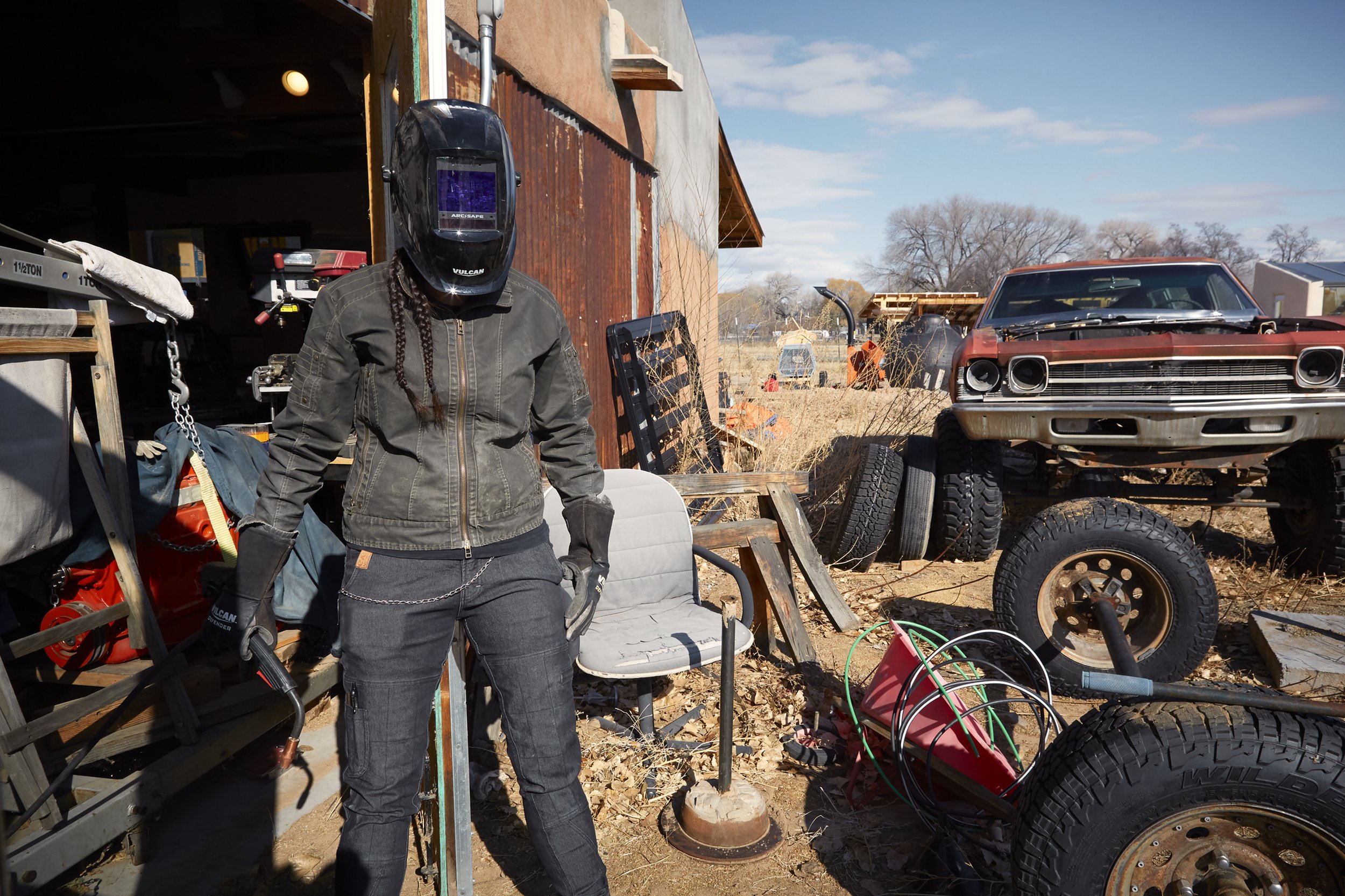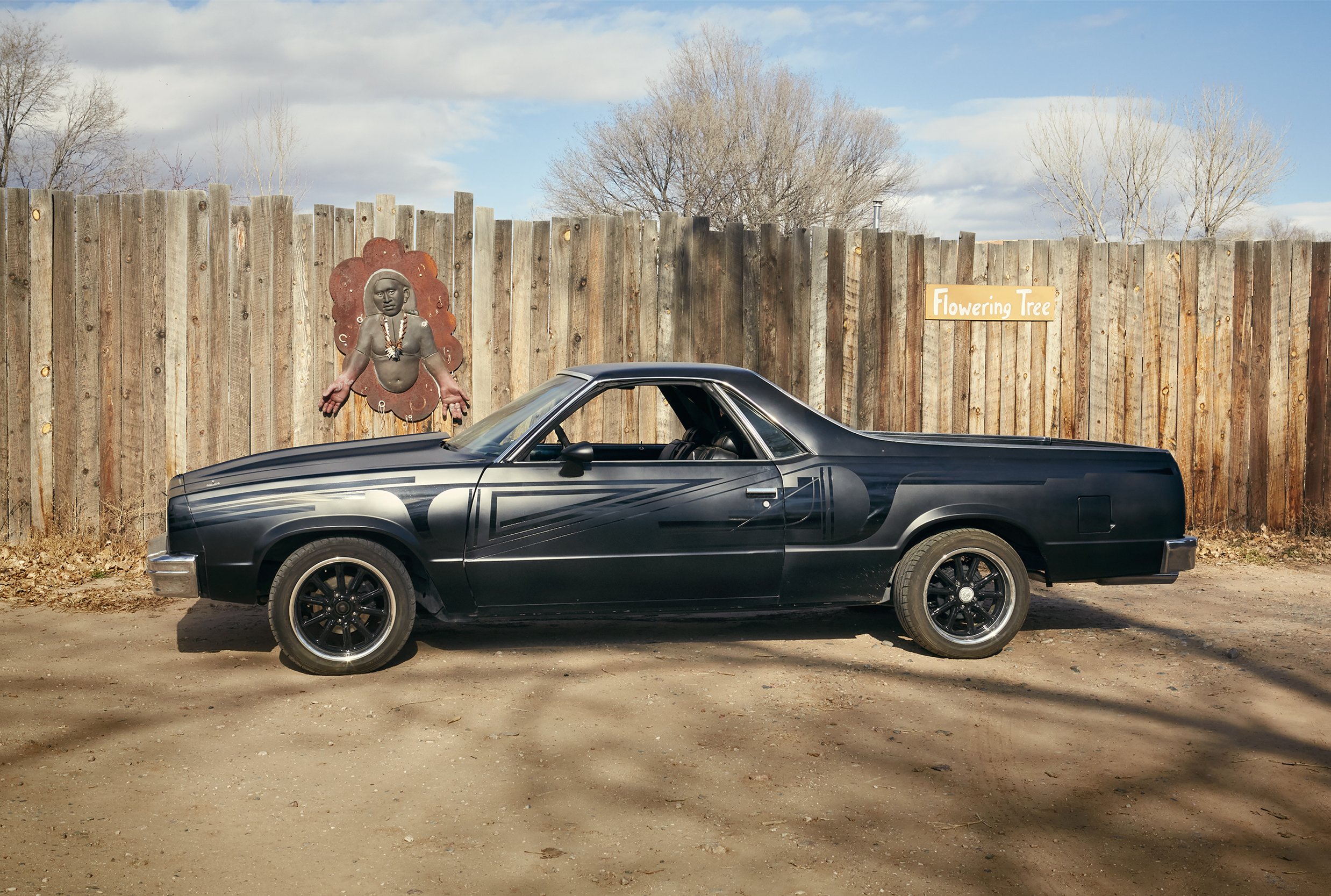Words Daniel Fuller Photography Kate Orne
Published in No 16
Beneath Simpson’s hitech gear, her ancestral line runs deep. Pottery making has been in her family for 700 years.
On the west bank of the Rio Grande, about 25 miles north of Santa Fe, near the mysterious Black Mesa, you will find the Santa Clara Pueblo. Known as “Village of Wild Roses,” it is famous for the distinctive glossy-black over matte-black pottery design pioneered by Maria Martinez. It's here that pottery has been in Rose B. Simpson's family for the past 700 years.
Clay runs deep in her ancestral line. Her late great-grandmother, Rose Naranjo, the matriarch, taught pottery making to all ten of her children. Her late grandmother, Rina Swentzell, was an architect, a potter, and a fierce activist, one of the first people in the Pueblo to get a Ph.D. Her mother, Roxanne Swentzell, is a ceramic sculptor, educator and founder of the Flowering Tree Permaculture Institute. As Simpson and I spoke, I kept thinking of her lineage.
In 2009, Simpson entered the master's degree program in ceramics at the Rhode Island School of Design, in Providence. It was an opportunity to study material, process and technical and conceptual exploration. But there was a disconnect: the school perpetuated the idea of art being separate from life. She described the experience as having "strummed at the rubber band that connected me to home." Back in the red foothills of the Sangre de Cristo mountains, in the Espanola Valley, clay played a role in all aspects of life. As a young mother, Roxanne Swentzell and her two young children built their family home with adobe. The kids would mix the mud for their mother’s brick laying. Clay was the land they farmed. Clay was the dishes they ate off. Clay was where they laid their heads at night. They knew the dirt. It’s in their family blood.
Work in progress, Heights III, 2023, and Road Less Traveled, 2023.
Simpson declined the traditional MFA rite of passage, “After graduating, there was this moment where people were like, 'Let’s all move to New York City. See what we can do.' And I was like, 'Nah, I need to go grow some food,'" Simpson returned to the unpaved earth of northern New Mexico to pull weeds and harvest the fields with her mother with a new respect for clay and a new gratefulness for home. Whether true or not, in the 1980s, her town, Española, declared itself the Lowrider Capital of the World. The title stuck.
In New Mexico, the Land of Enchantment, Española has complicated energy. It’s a poor community in a state with one of the highest poverty rates in the U.S.. Simpson remembered, as a kid, driving through town and passing mobile homes that barely seemed habitable, with plastic over the windows and pit bulls patrolling dusty yards. And yet, parked behind the fences were these cars representing so much more than meets the eye. These modified cars are cornerstones of the community, modes of self-expression, and expressions of faith. They are rolling sculptures, works of art in everyday life. Simpson said, “As long as you can go out and feel a sense of pride, you have something to live for."
Simpson bought her first car at 12 years old. After grad school, her passion for cars inspired her to enroll in an automotive science program at Northern New Mexico College. It was here where she started to work on a 1985 Chevy El Camino that she would later title Maria, named after Maria Martinez.
The 1985 Chevy El Camino that Simpson titled Maria, after artist Maria Martinez.
Simpson grinding a new sculpture in her workshop. Remind, 2023. It was exhibited in her solo show at Jack Shainman Gallery.
As an artist continuously pushing the limits of ceramic figurative sculptures, Maria is the closest Simpson has come to making traditional pottery. She has a massive engine, and she prefers to go fast, featuring designs created with automotive paint in a satin-black and high gloss geometric design inspired by Tewa community pottery. The patterns mimic the rolling flow of the region's rivers, valleys and mountain ranges. Look at the car from the right angle and the land and landscape reflect in the gloss.
Maria, the El Camino, is a car rooted in Latino cruise culture. She was restored by a woman working in a traditionally male pursuit. She is a pure representation of this remarkable place — an olive branch, an attempt to find common ground. It is ultimately a symbol of strength and survival in the face of the significant complications of history. The Pueblo was first visited when a Conquistador expeditionary force came to the area in 1541. Simpson explained that Northern New Mexico is a "tri-cultural area." Even before the Spanish colonizers, a layer of indigenous colonizers, Athabaskans, modern Navajo, and Apache, were early enemies. Then the American colonizers, pushing west, arrived. They have now all co-existed for centuries — deep, complicated relationships steeped in memories of pain and fear. Maria is an act of empowerment for all disenfranchised people. Simpson describes her commitment to the region: "I don't just represent the tribe; I represent the larger community."
Simpson has continuously inhabited and navigated various worlds. When living in Providence, many cross-country flights were taken for a seat around the Feast Day table. Even now, as her monumental ceramic sculptures are being shown in museums and galleries across the country, she remains in New Mexico. "For Pueblo people, we're place-based. Our ceremonial and spiritual belief systems are place-based, so the prayers, the songs, etcetera, reference actual mountains and physical places here." She is grounded in her spiritual beliefs. Life pulls in many directions, but Simpson is rooted here.
A 1964 Buick Riviera, a future project.
The blue door to her studio.
Pueblo societies have a pervasive aversion to individualistic behavior. There is a continuous reminder that one’s work is not solely one’s own but a story of the whole community. But Simpson comes from a matrilineal lineage that paved the way towards pushing the boundaries. Artists have been kicked out of the tribe for making art deemed inappropriate. This was necessary after a tumultuous period that included oppression by assimilationists and cultural imperialism by anthropologists and tourists. Pueblo artists used numerous tactics, such as misdirection and masking to make their art, create what they wanted, and control the flow of information to the outside world. But an artist that runs afoul of the tribal council with art that is inconsiderate of the larger community, to this day, can be expelled from the tribe and lose everything they own.
I keep thinking about how art can become an intergenerational voice, rolling down the hill, gaining power, gaining mass as it tumbles. Simpson explained that her great-grandmother Rose (Naranjo) was in Indian boarding schools and, if she antagonized the colonizer too much, her life was in danger. But she pushed. Simpson’s grandmother Rina was this brilliant woman who challenged many norms both in and out of the Pueblo community, arguing for the rights of all. In the '80s, her mother Roxanne began making realistic figurative sculptures of Koshares, or Scared Clowns, that went against the custom of keeping these images abstract. It's the push and pull of inching toward a line while still respecting it. Simpson says her culture has created these belief boundaries. Essentially guides that keep one accountable and considerate of the community.
Her studio is a perfect cylinder, at 154 sq feet, taller than it is wide. Every bit of it is in use. Due to the size, Simpson must make her sculptures in parts and then build them outside in the sun. The clay is continuously thrown against a flat surface until it thins, a technique she calls “slap-slab.” She quickly builds up the clay, layer on layer, before it can dry. It's both fragile and immediate: the process demands total commitment. With the impressions of her fingertips, Simpson's presence remains with the works wherever they might travel. The clay records her emotion. I wondered if her russet-colored figures were from clay from northern New Mexico, but they were not. She rarely, if ever, extracts organic matter to be used in her pieces. Her people have already given so much away.
Simpson assembling Heights III, 2023.
Her studio is a perfect cylinder at 154 sq ft, taller than wide, every bit is in use.
Many of the works feature a representation of the body. The figures frequently exclude individual characteristics that would distract from their presence. They are stoic. Often leaning or exposing their elongated necks as an act of faith, a willingness to connect. Despite their hollow interiors, seen primarily through the emptiness of the eyes, the figures are watchful. To commune with them is to fill up that space, to consider your relationship to the gifts offered by the earth. In being a witness of self, we restore sight to all things.
Throughout her exhibition history, the number 12, as in the number of sculptures in a show, has reoccurred numerous times, most recently in Road Less Traveled, her solo exhibition at Jack Shainman Gallery, in New York. The number's significance originates from an old story Simpson heard in Santa Clara Pueblo, which contains many themes and philosophies that have become common in religious, literary, philosophical, and recovery worlds. Be it “the hero's journey” about a character going on an unexpected journey, having their character, faith, strength and skills tested before returning home triumphant or Matias de Stefano's belief that our souls make 12 stops before we are reincarnated. The common thread in each of these stories is faith.
You see the same raw and honest approach in Simpson's work as you do in her social media feed. She often shares moments of shame and vulnerability. When she thinks back to grad school, there was this demand to explain a whole identity, the patterns, the symbolism, the cultural language. It was just as extractive as pulling the clay from the ground. Simpson did not want to lay out her cultural information and call it her art. She desires to be able to share without being made a noun. She is constantly maintaining the chance to be a verb, the opportunity to grow.
Like life, clay is so fragile; it demands you to be present. With so many deadlines and much work to be done, I wondered when there was a sense of peace, a pause, a moment to herself. As it did many times in our conversation, it went back to the empowerment of being behind the wheel. "I've been thinking so much about the idea of throwing a cruise (a key tenant in the lowrider lifestyle, a term for the social activity of driving slow, sometimes aimlessly, sometimes on a predetermined strip). Because they would say, ‘Let's go throw a cruise. Are you gonna hit the cruise line?’ I keep thinking about now in my busy life and the importance of throwing a cruise. And even if that's wandering off into the hills on foot where you have no destination, you're very present in the moment and have an aesthetic experience. It's applied aesthetics. It's art in the everyday. And a car is a vessel of a spiritual moment. I'm constantly searching for that cruise."
Rose B. Simpson is represented by Jack Shianman Gallery.
Daniel Fuller is a curator and writer based in Atlanta, Georgia. @fuller315
Kate Orne is the founder and editor of UD.










